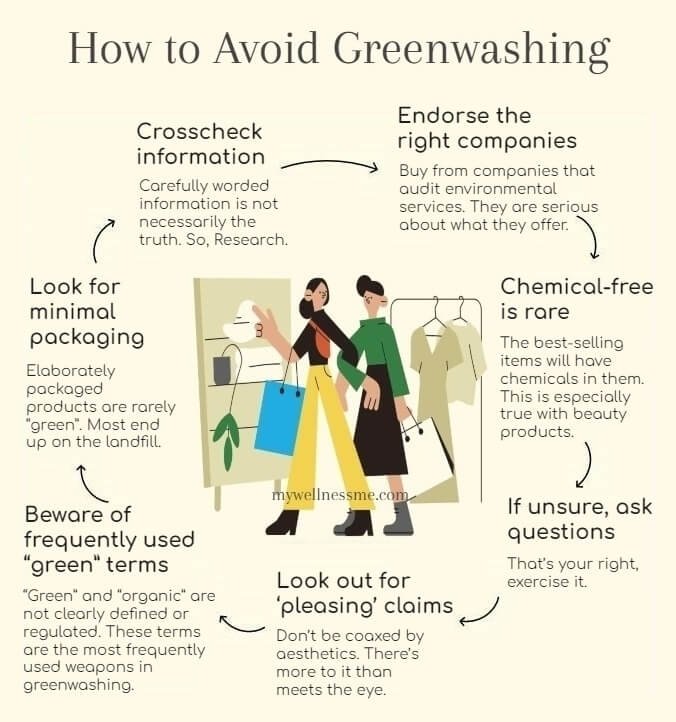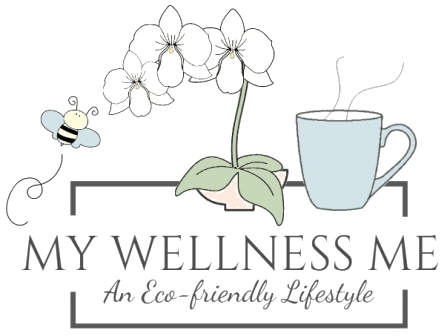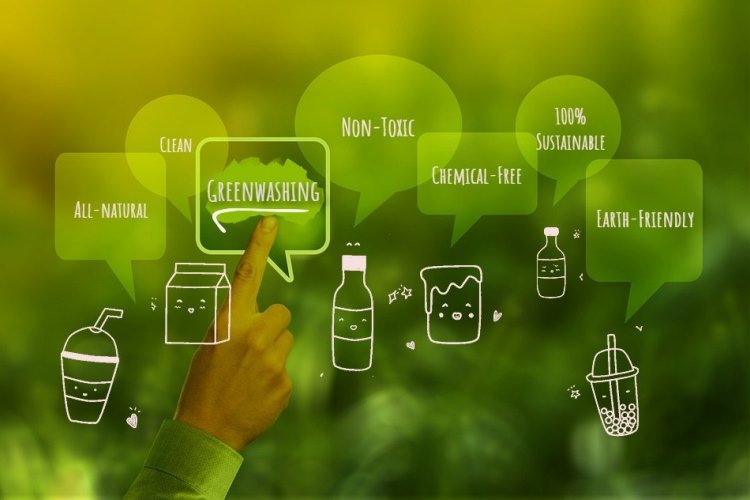In this day and age, it’s hard to find a company that doesn’t promote environmental sustainability and eco-friendliness in its products and services. At first, this seems great! But when we pull back the curtain a little, we find that some companies aren’t really practicing what they preach.
‘Greenwashing’ is the practice of falsely or disproportionately claiming a company’s product is environmentally sustainable. This marketing tactic uses misleading, exaggerated, or even just false information to convey eco-friendliness as a means to boost sales.
There are several different types of greenwashing, including:
- Misleading labels
- Misleading imagery
- Irrelevant claims
- Hidden trade-offs
Let’s look at the above in detail and learn how we can avoid greenwashing by identifying false claims of sustainability.
Greenwashing as a marketing tactic
Before we get into greenwashing strategies, let’s take a closer look at the term itself.
Greenwashing is nothing new. The term was first coined in 1983 by ecologist Jay Westerveld. It became widely recognized several years later when Chevron released a popular advertisement campaign depicting the oil company’s commitment to protecting wildlife.
The commercials showed how Chevron altered its practices to protect wildlife and nature. However, in reality, most of those practices were baseline environmental standards that all oil companies legally had to follow.
The campaign is now considered a gold standard of greenwashing, where it wildly overexaggerates the company’s commitment to the environment, convincing consumers that the product is far more environmentally conscious than it is.
Since the 1980s, greenwashing has become a widely used marketing strategy. A 2021 study headed by the European Commission found that 42% of eco-friendly claims were exaggerated, deceptive, or bluntly false. In addition, 59% of the evaluated cases lacked substantial evidence to support their green claims.
So, why do companies make these misleading claims instead of shifting towards environmentally sustainable practices?
The simple answer: people are willing to pay more for sustainability.
Studies have shown that people are willing to pay an average of 5-10% more for products that are eco-friendly, and that the number of people who go out of their way to buy sustainable products is growing (which is great!).
The problem, of course, isn’t with consumers but with companies making false claims that many consumers don’t know how to dispute. Further, as the popularity in sustainable products rises, greenwashing tactics get more and more complex.
Types of greenwashing
There are several different types of greenwashing to look for. Most types generally fall into four different categories: irrelevant claims, misleading labels, misleading imagery, and hidden trade-offs.
1. Irrelevant claims
One of the most commonly used forms of greenwashing comes from companies that disproportionately promote actions or ingredients as sustainably-driven choices.
This can come in many forms. Examples of this type of greenwashing include when companies reduce packaging materials to cut costs, or claim that products are “chemical free”. The claims may be true, but they are not relevant to sustainability efforts. Instead, these kinds of claims give the false impression that the company is working towards sustainability.
In reality, the chemicals in question may be banned, or the company was planning on phasing out plastic packaging due to changing industry standards.
The infamous Chevron campaign was an example of this. Federal environmental regulations forced the company to alter their drilling schedules, rather than Chevron actively taking a role in sustainability.
In fact, the term ‘greenwashing’ was first coined when Jay Westerveld noticed that large beachside hotels were asking customers to reuse towels to protect the corals and marine life. At the same time, they were expanding new multi-million dollar beachfront properties.
2. Misleading labels
When we’re out shopping, most of us give the labels of a product a quick scan, looking for words like “organic”, “certified”, or “recycled”. These are typical buzz words that companies use as marketing tactics to capture our attention and get us to put their products in our carts.
The truth is, though, that those words rarely have any substance to them. The organic label is commonly misused in this way. Oftentimes we see products that are “made with organic materials”. This can mean a number of things. When food is organically made, i.e., made with environmentally conscious farming practices and limited synthetic chemicals, it will have the USDA “organic certified” seal.
However, products are allowed to use the “made with organic materials” label with only 70% organically made ingredients. The remaining 30% may go undisclosed on their sustainability and health practices.
Other misleading labels include vague tags like “certified” or “verified sustainable”. In many cases, these are self-declared labels that may not hold much value. If you come across this type of labeling, look for further information. Find out who provided the certification. If the product doesn’t provide more information other than an eye-catching label, there’s a good chance it’s greenwashing.
That said, some companies actually do undergo voluntary testing or certification to ensure safety and sustainability. Labels to look out for include GOTS labels (organic cotton certification), Higg Index certification (sustainable clothing standard) and Fair Trade certification (sustainable and ethical production label).
3. Misleading imagery
Graphic design is a fantastic marketing technique that can change our entire perception of a product or a brand. Unfortunately, this is a technique that can easily be used against consumers who are looking for eco-friendly products.
When we buy products with sustainability in mind, we may keep our eyes out for green-colored packaging. Also, we may look for images of open fields and lush forests that imply sustainable products.
However, nature-based packaging alone rarely means a product is made sustainably.
Instead, companies use this imagery to give the false impression of green-minded products, without providing any information on how the product is sustainable. Think of bottled water that labels its packaging with green forests and mountainscapes. This gives us the impression that the water is fresh, clean, and sustainable. In reality, the product is a single-use water bottle that was made with little to no sustainability in mind.
Products that are actually made with eco-conscious practices are typically packaged with simpler imagery and less packaging. Colorful printing is avoided as it can be both expensive and harmful to the environment.
4. Hidden trade-offs
Hidden trade-offs occur when corporations promote environmentally sustainable practices without addressing the major environmental concerns of the industry. A prominent example of this is when clothing brands, especially fast-fashion companies, promote the use of “recycled” or “natural” material. The material used may mitigate a small percentage of the environmental costs. However, the clothing is actually manufactured through exploitative conditions that contribute to significant amounts of chemical pollution and greenhouse gas emissions.
This is also commonly used in the footwear industry, where companies claim that shoes are made from recycled or recyclable materials. In reality, most products will deteriorate over time beyond being recyclable and eventually end up in the landfill.
Instead, look for companies that use environmental auditing services to ensure sustainability throughout their manufacturing processes. This helps companies actively improve their sustainability efforts and ensures transparency throughout their supply chains and to their buyers.
How to identify and avoid greenwashing

As we become more environment-conscious in our purchasing habits, it’s important to be able to identify greenwashing tactics to ensure our purchases are actually green.
The easiest and quickest way to avoid greenwashing is to identify false claims is by looking for clear and concise information. Does a company provide information on how they’re promoting sustainability? Do they list statistics and figures for their improvements and efforts? Look for products that clearly define their environmental practices, instead of using vague descriptions and indistinct labels.
Companies that are truly sustainable will do everything in their power to ensure that their products do minimal damage to the environment. Furthermore, they are aware that the perfect green product does not exist, and so do not exaggerate the claims.
When corporations are truly committed to the environment, they will spare no details in proving it. Be on the lookout for businesses that promote transparency to their buyers and offer easily accessible information. In most cases, the difference between greenwashing and genuine sustainability comes down to the information available.
Have you succumbed to greenwashing practice? Let us know us in the comments.
Guest Contributor



10 comments
I have never heard of the term greenwashing before but after learning its meaning, I can say that many companies definitely use this marketing tactic and it sucks that so many companies are dishonest for the benefit of profit. Thank you for sharing!
You’re welcome 🙂 . And it’s true – companies will do anything to make us believe that we are buying the perfect ‘green’ product.
This was such an informative post! I hadn’t heard of greenwashing before but it’s such a massive issue, and your tips will definitely help with spotting these companies. I love the diagram you provided and I think checking the claims is key! Thank you so much for sharing x
You’re welcome and I am glad you enjoyed the post : )
Loved reading this and getting an idea of what to watch out for, as companies will weaponize everything they can to increase their sales, be it promotional materials or just packaging. It is good to know the USDA organic label still carries some weight, and your useful graph is super handy to have around!
Thanks Jaya. You’re right; companies will pull no stops for a little profit. These days, it’s become increasingly difficult to tell which ones are authentic.
We have never heard the term greenwashing before, but we certainly understand that companies do it. Companies will always promote environmental sustainability in the public sphere, but go on doing the same thing until someone holds them accountable for the negative externalities they create for all of us. Thank you for sharing this! This post is very informative and valuable.
You’re welcome. I am glad you find the post useful. Alas, most companies will do what brings them profit.
Thank you for sharing this information regarding greenwashing. You made some great points and I agree with you. There’s a lot of false advertising and misleading information regarding products. It’s really important to do research and fine prints including the ingredients, etc. Enjoyed reading. 😀
Pastor Natalie (ExamineThisMoment)
Thanks. Research and getting to the heart of the matter is vital to spot the real ones from the frauds. Companies market themselves so well that it’s hard to tell.
Comments are closed.